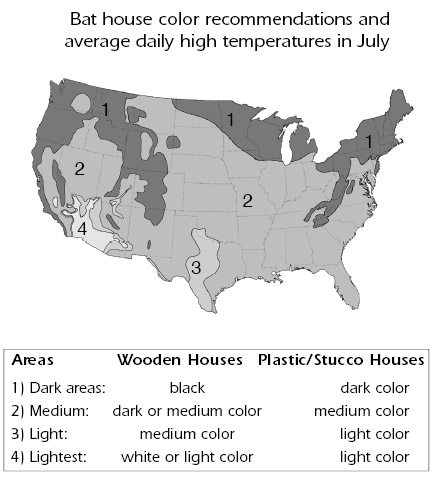Our Bat Houses
Our Bat Houses are available for Purchase in our Bat-eStore!
Exactly what makes a good bat house was not known until recently thanks to decades of research. I sincerely appreciate and acknowledge all the bat biologist and their hard work without which we would all suffer a great loss. Because of their efforts and organizations like Bat Conservation International we know bats prefer a nice, dry, draft free home much like humans. They don’t like roof leaks or cold drafts any more than we do and they have very specific preferences for chamber sizes and roosting grips.
Habitat for Bats uses quality exterior AC grade plywood, Cedar, Cypress and/or high quality composites as called for in each design. Only weatherproof fasteners and screws are used and all exterior joints are sealed with a 50 year polyurethane adhesive during assembly. We only use cut grooves in our roosts giving bats a natural and permanent gripping texture that will never become loose entangling or injuring bats. Internal baffles are spaced ¾” to 1″ apart depending on the bat house model. Research has supported that this spacing is what bats prefer. Depending on the model, roofs are either shingled or composed of a high quality UV resistant composite. The roof design improves appearance, durability and maximizes solar heating. Finally, the house exterior is painted to order with several coats of high quality paint.
Your new Habitat for Bats bat house comes completely finished with a manual that includes detailed suggested mounting procedures making installation easy even if you are working alone. We take our bat houses very seriously and do what we can to make sure our houses are complete, easy to mount and last decades once installed. Our manual is more comprehensive than a flyer and includes details such as color choices in case you decide to repaint your house, mounting guidelines and sample pole designs.
So now you’re thinking “that’s great, but which bat house should I buy?” Generally, we suggest the largest bat house you can reasonably expect to have space to hang. While this may seem like an “of couse you want me to buy the most expensive house” answer, it really isn’t. Larger houses retain and buffer heat exchange better than smaller houses and provide more internal area for roosting, birthing pups and nursing hungry pups. You need to consider where you will be hanging the house. Is the space large enough and strong enough to support the weight? How many bats would you be comfortable with roosting in the area? While a larger bat house is no guarantee of a large colony, it does offer the potential.
Now you are probably wondering how many bats these houses will hold. We list our houses with a stated roosting volume in cubic inches. I cannot, in good conscience, tell you our single chamber house will hold 150 bats even though others advertise a smaller house as able to do so. I also don’t know which species of bat will roost in your house. The roosting density of different species vary widely. Instead, we state the cubic inches of roosting volume of our houses and you should ask other vendors to provide the same information so your can compare apples to apples. The more volume, the more bats.
Research has shown that Mexican Freetail bats will roost perhaps as dense as 75 bats per 144 cubic inches of roosting volume. These means, in theory, a single chamber house with 250 cubic inches on roosting space will hold 130 bats. Unfortunately this kind of math is misleading. I suggest taking the volume of the house and dividing by 144 then multiplying by 75/2. That’s [(volume/144) x 37.5] For a single chamber house that comes to about 65 bats. In my experience and professional opinion that is about the most bats you can reasonably expect to squeeze into a single chamber house. Results will still vary based on location and species and I will continue to update this formula based on real world research. Still, 65 flying bug eaters can make quite an impact every evening.
You’ve probably noticed we offer three bat house colors and you’re wondering which one to choose. The simple answer is the hotter your climate, the lighter color you should choose. Bats prefer a roosting temperature between 85 and 100 degrees. In the Northern States a dark shade of color (very dark brown or almost black) is the best option, it absorbs heat quickly. In the desert and sandy States the lighter color does well. For the moderate areas, a medium shade of color is a good choice. But remember, moderate means for the bats, not you and they prefer it hot. In mid to north Georgia the medium color shade houses (like a medium brown) seem do well though we have had good luck with much lighter shades of colors on bat houses too. And remember, you can always custom paint it to your own shade of color.
I said that was the simple answer. Next you have to consider where the bat house will be mounted and if it will get enough sun (it needs sun most of the day normally). If you live in a hot area like Texas or Arizona but your bat house is going to be partially shaded and on an open pole, the medium color may be a better choice. If you are north and your house will be mounted on a brick building that retains a lot of heat in direct sunlight, instead of the dark shade you might opt for the medium shade. Use the following color chart as a guideline to help you make your choice.

